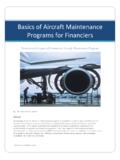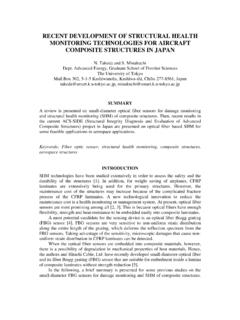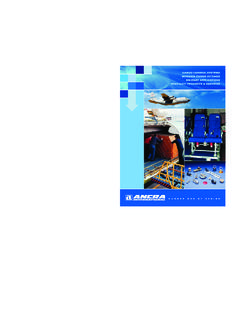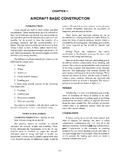Transcription of Aircraft Hangars - mercfire.com.au
1 CHEMGUARD INC. 204 S. 6th Avenue Mansfield, Texas, USA 76063 (817) 473-9964 FAX (817) 473-0606 Rev: 09/2003 Page X - 1 DESCRIPTIONC onsidering the value of commercial andmilitary Aircraft , it has become extremelyimportant to have a reliable fixed fire protectionsystem in Aircraft storage, servicing,maintenance and paint facilities. This fireprotection system is designed to givereasonable control and extinguishment of anyClass A or B type fire in the fire protection systems for aircrafthandling facilities are designed in accordancewith NFPA 409 (2001) Aircraft Hangars , or theAirforce ETL 02-15 (Engineering TechnicalLetter) Fire Protection Engineering Criteria forAircraft Maintenance, Servicing and StorageFacilities. Per NFPA 409 there are four basicaircraft hangar designs that have beenclassified:GROUP I Aircraft HANGAR A hangarhaving at least one of the following features andoperating conditions: An Aircraft access door height over 28 ft.
2 ( m) A single fire area in excess of 40,000 sq. ft.(3,716 sq. m) Provision for housing an Aircraft with a tailheight over 28 ft. ( m) Provision for housing strategically importantmilitary Aircraft as determined by theDepartment of DefenseGROUP II Aircraft HANGAR A hangar hav-ing both of the following features: An Aircraft access door height of 28 ft. ( ) or less A single fire area not larger than 40,000 (3,716 sq. m) per hangar constructiontype as defined by NFPA 409 Single Fire AreaType of Equal or Greater Than But Not Larger ThanConstruction Sq. Ft. (M2) Sq. Ft. (M2)Type I (443)and (332) 30001 (2787) 40000 (3716)Type II (222)20001 (1858) 40000 (3716)Type II (111),Type III (211), andType IV (2HH) 15001 (1394) 40000 (3716)Type II (000) 12001(1115) 40000 (3716)Type III (200) 12001 (1115) 40000(3716)Type V (111) 8001 (743) 40000 (3716)Type V (000) 5001 (465) 40000 (3716)GROUP III Aircraft HANGAR A Group IIIhangar may be a freestanding unit for singleaircraft, a row hangar housing multiple aircraftthat has a common structural wall, roof systemand openings for each Aircraft or an open bayhangar capable of housing multiple Aircraft withthe following features: An Aircraft access door height of 28 ft.
3 ( ) or less A single fire area that measures up to themaximum square footage permitted forspecific types of construction per NFPA 409 MaximumType of Single Fire AreaConstruction Sq. Ft. (M2)Type I (443) and (332) 30000 (2787)Type II (222) 20000 (1858)Type II (111), Type III(211) and Type IV (2HH) 15000 (1394)Type II (000) 12000 (1115)Type III (200) 12000 (1115)Type V (111) 8000 (743)Type V (000) 5000 (465)Building construction types are defined in NFPA220, Standard on Types of Building HangarsCHEMGUARD INC. 206 S. 6th Avenue Mansfield, Texas, USA 76063 (817) 473-9964 FAX (817) 473-0606 Rev: 04012001 Page X - 2 GROUP IV Aircraft HANGAR A Group IVhangar may be a member-covered, ridge, steelframe structures limited to single story height, asingle fire area, used for storage and service PROTECTION OPTIONSOnce the Aircraft hangar classification has beendetermined, a suitable fire protection system/requirement can be established.
4 There are fourtypes of foam fire protection systems suitablefor the protection of an Aircraft hangar. Thesesystems may be used separately or they maybe combined. Overhead foam water sprinkler system Foam monitor system Foam hand hose line system High Expansion foam systemThe overhead foam water sprinkler system canbe: Closed head pre-action Standard wet pipe Deluge systemIf used with either Protein or Fluoroprotein typefoam concentrate, the foam water sprinklerheads must be air-aspirating. When used withAFFF, the sprinkler heads can be standard nonair-aspirating. When using Protein orFluoroprotein foam use an application rate of gpm per sq. ft floor area, AFFF systemsshall use an application rate of gpm persq. ft of floor Systems: May be of the oscillating orfixed nozzle Monitor Systems consist of monitorsthat automatically oscillate from side to sidewhen discharging foam onto the hangar are normally preset to oscillate over agiven arc to provide a flow rate over a Monitor Systems have nozzles that aretypically mounted on a manifold or as singleunits approximately 3 feet above the hangarfloor.
5 They are preset for angle of elevation anddischarge pattern to achieve the best possiblestream pattern and range while keeping thestream low enough to flow under the wing ofany Aircraft . This type of monitor system is oftenused where Aircraft or maintenance equipmentin the hangar could interfere in the normaloperation of the oscillating type Hand Lines: These systems arerequired as supplementary protection in Group Iand II Aircraft Expansion Systems: These systems aredesigned to discharge an expanded mass offoam bubbles over the protected area to adepth of at least 3 ft. within 1 minute and flowfor a minimum of 12 I HANGAR FIRE PROTECTIONDESIGN REQUIREMENTSP rotection of Group 1 Aircraft Hangars , otherthan those housing unfueled Aircraft , shall beone of the following options:A. A foam water overhead deluge system. Ifthe hanger houses single Aircraft havingwing areas greater than 3000 Sq.
6 Ft. Asupplementary protection system consistingof either a low level oscillating monitorsystem or a low level high expansion foamsystem shall be provided covering the floorarea beneath the Aircraft being AFFF systems designed for 10 The system shall achieve controlof the fire within the protected area within 30seconds of system actuation andextinguishment of the fire within A combination of a closed head watersprinkler system* AND an automatic lowlevel low expansion foam system designedper the requirements of NFPA A combination of a closed head watersprinkler system* AND an automatic lowlevel high expansion foam system designedper the requirements of NFPA 409 (see highexpansion foam system worksheet fordetails).CHEMGUARD INC. 206 S. 6th Avenue Mansfield, Texas, USA 76063 (817) 473-9964 FAX (817) 473-0606 Rev: 04012001 Page X - 3*Note: The water sprinkler system for Group 1hangars is to be designed for Gpm per over any 15,000 sq.
7 Ft the foam-water sprinkler system is also usedfor column fire protection within the hangar inlieu of the column having a fire resistive ratingof not less than 2 hours, allowances must bemade for the required additional reserve supply of foam concentrate must bedirectly connected into the system and bereadily available if hand hose systems shall beinstalled if the Aircraft DO NOT have drainedand purged fuel Expansion Foam SystemThe generators should only be mounted at theceiling or on exterior walls of the hangar whereoutside air only is used to generate the is recommended that the high expansiongenerators be installed so that the flow of foamon the floor is directed to areas immediatelyadjacent to, but not directly onto the II HANGAR FIRE PROTECTIONREQUIREMENTSThe fire protection requirements of a Group IIhangar may be one of the In accordance with the requirements for aGroup I hangarB.
8 A combination of a closed head watersprinkler system* AND an automatic lowlevel low expansion foam system designedper the requirements of NFPA A combination of a closed head watersprinkler system* AND an automatic lowlevel high expansion foam system designedper the requirements of NFPA 409 (see highexpansion foam system worksheet fordetails).D. A closed head foam water sprinkler systembased on the same design requirements asoption as A III HANGAR FIRE PROTECTIONREQUIREMENTSA. Fixed fire protection systems are notnormally If any hazardous operations such as fueltransfer, welding, painting, torch cutting, performed in a Type III hangar, thehangar should be protected as per a Type IIaircraft IV HANGAR FIRE PROTECTIONREQUIREMENTSW here the hangar fire area housing unfueledaircraft is greater than 12,000 sq. A low expansion foam system gpm/sq.
9 Ft. over the entire storage andservice A high expansion foam system providing 3cu. per sq. ft. over the entire storageand service An automatic water sprinkler meeting thefollowing: Closed head sprinkler meeting NFPA 13 Quick response water sprinkler heads A design application rate of ft. over any 5000 sq. Requirement for all Type extinguishers must be distributedthroughout the Aircraft hangar per NFPA 10 Standard for Portable Fire System Application InformationOverhead primary protection systems. Discharge duration - 10 minutes Application rate gpm per sq. ft. / AFFF throughstandard sprinkler gpm per sq. ft. / Protein,Fluoroprotein or AFFF through airaspirating sprinkler heads A reserve supply of foam concentrateCHEMGUARD INC. 206 S. 6th Avenue Mansfield, Texas, USA 76063 (817) 473-9964 FAX (817) 473-0606 Rev: 04012001 Page X - 4 should be directly connected to the systemand be readily available.
10 If the foam concentrate is injected into thewater supply by a foam pump, there are tobe two pumps (one main, one reserve),either of which can provide the necessarysupply of foam concentrate at the designrate. When using a 1% foam concentrate,multiply the total foam solution required to obtain the quantity of foamconcentrate required. Multiply by .03 whenusing a 3% concentrate and by .06 whenusing 6%.SUPPLEMENTARY PROTECTION SYSTEMSM onitorsEach supplementary fixed foam fire protectionsystem is to be designed to achieve control ofthe specified floor area within 30 seconds ofactivation and to extinguish any fire within 60seconds. The specified floor area is the areaunder the wing and the wing center section ofthe Aircraft . The different configurations ofaircraft and their positioning within the hangarmust be considered for effective fire protectionwhen positioning the more than one Aircraft is located within anydrainage system, it is recommended that thesupplementary foam monitor system becapable of effectively covering the completefloor beneath all flow rates through supplementarymonitor systems for the area of coverage is tobe gpm per sq.







